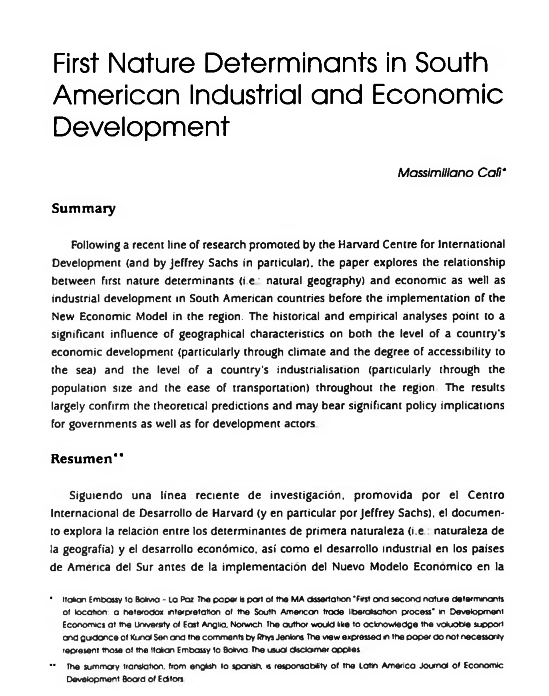Determinantes de primera naturaleza del desarrollo industrial y económico de América del Sur
DOI:
https://doi.org/10.35319/lajed.20043316Palabras clave:
Nuevo modelo económico, Desarrollo industrial, Desarrollo EconómicoResumen
Siguiendo una línea reciente de investigación, promovida por el Centro Internacional de Desarrollo de Harvard (y en particular por Jeffrey Sachs), el documento explora la relacion entre los determinantes de primera naturaleza (i.e.: naturaleza de la geografia) y el desarrollo económico, así como el desarrollo industrial en los países de América del Sur antes de la implementación del Nuevo Modelo Económico en la región. Los análisis históricos y empíricos apuntan hacia una significativa influencia de las características geográficas (particularmente a traves del clima y el acceso al mar) y de los niveles de industrialización del país (particularmente por el tamaño de la población y las facilidades de transporte) en los niveles de desarrollo económico de los países de la región. Los resultados confirman ampliamente las predicciones teoricas y podrian incluir significativas implicaciones de política tanto para gobiernos como para agentes de desarrollo.
Descargas
Citas
Acemoglu, D., S. Johnson and J. A. Robinson, 2002. "Reversal of fortune: geography and institution in the making of the modern world income distribution". Quarterly Journal of Economics. 117, 1231- 94.
Alcorta, M. and W. Peres, 1995 "Investment in innovation and technological adaptability in Latin America and the Caribbean". The United Nations University Intech. Discussion paper N° 9509.
Bakewell, P. 1984. "Mining in colonial Spanish America" In: Bethell L., ed. Cambridgehistory of Latin America. Vol. II 105-151. Cambridge Cambridge University Press.
CEPAL, 2001. Una década de luces y sombras. América Latina y el Caribe en los años noventa. Santiago de Chile: Alfaomega.
Diamond, J. 1997. Guns, germs, and steel: the fates of human societies. New York: W. W. Norton.
Dickenson, J. 1996. "The rise of industry in a world periphery". In: Preston. D., ed. Latin American development. Harlow Longman.
Easterly, W. and R. Levine. 2002. "Tropics, germs and crops how endowments influence economic development". NBER. Working Paper N° 9106.
Gallup, J. L. 1998. "Agricultural productivity and geography" Mimeo. Harvard Institute for International Development.
Gallup J. L., J. D. Sachs and A. D. Mellinger. 1998. “Geography and economic development" NBER. Working Paper N° 6849.
Hirschmann, A. 1958. The strategy of economic development. New Haven, CT: Yale University Press.
Krugman, 1998. "The role of geography in development". Paper prepared for the Annual World Bank Conference on Development Economics. Washington DC.
Landes, D. 1998. The wealth and poverty o f nations. New York: W .W. Norton.
Larrain, F. B., J. D. Sachs and A. M. Warner. 1999. "A structural analysis of Chile’s long term growth history, prospects and policy implications”. Document prepared for the Government of Chile.
Montesquieu, C. L., 1750. The Spirit o f Laws (English version: New York: Cambridge University Press, 1989).
Moreira, M. M. and P. G. Correa. 1998. "A first look at the impacts of trade liberalization on Brazilian manufacturing industry" World Development. 26 (10) 1859-74.
Newson, L. A. 1996. "The Latin American colonial experience". In: Preston, D., ed. Latin American development. Harlow: Longman.
Ottaviano, GIP and J-F. Thisse. 2004. "New economic geography: what about the N?" Mimeo
Radelet, S. C. and J. D. Sachs. 1998. "Shipping costs, manufactured exports, and economic growth". Mimeo. Harvard Institute for International Development.
Rodrik D., A. Subramanian and F. Trebbi. 2002. "Institutions rule: the primacy of institutions over geography and integration in economic development". NBER. Working Paper N° 9.305.
Sachs J., 2003. “Institutions don't rule: direct effects of geography on per cápitaincome”. NBER. Working Paper N° 9490.
Stallings, B. and W. Peres. 2000. Crecimiento, empleo y equidad. Santiago de Chile: Fondo de Cultura Económica CEPAL.
Summers, R. and A. Heston. 1994. The Penn World Tables. Mark 5.6. http://www.nber.org/pwt56.html
UNDESA, 2001. World population ageing: 1950-2050. New York: United Nations.
Wood A., 2002. "Could Africa be like America?". Proceedings of the Annual World Bank Conference on Development Economics. Washington DC: World Bank.
World Bank. 2002. World Development Indicators. CD-ROM.
Zattler, J. 1996. "Trade policy in developing countries a new trade policy consensus?" Intereconomics. 31(4), 229-236.





